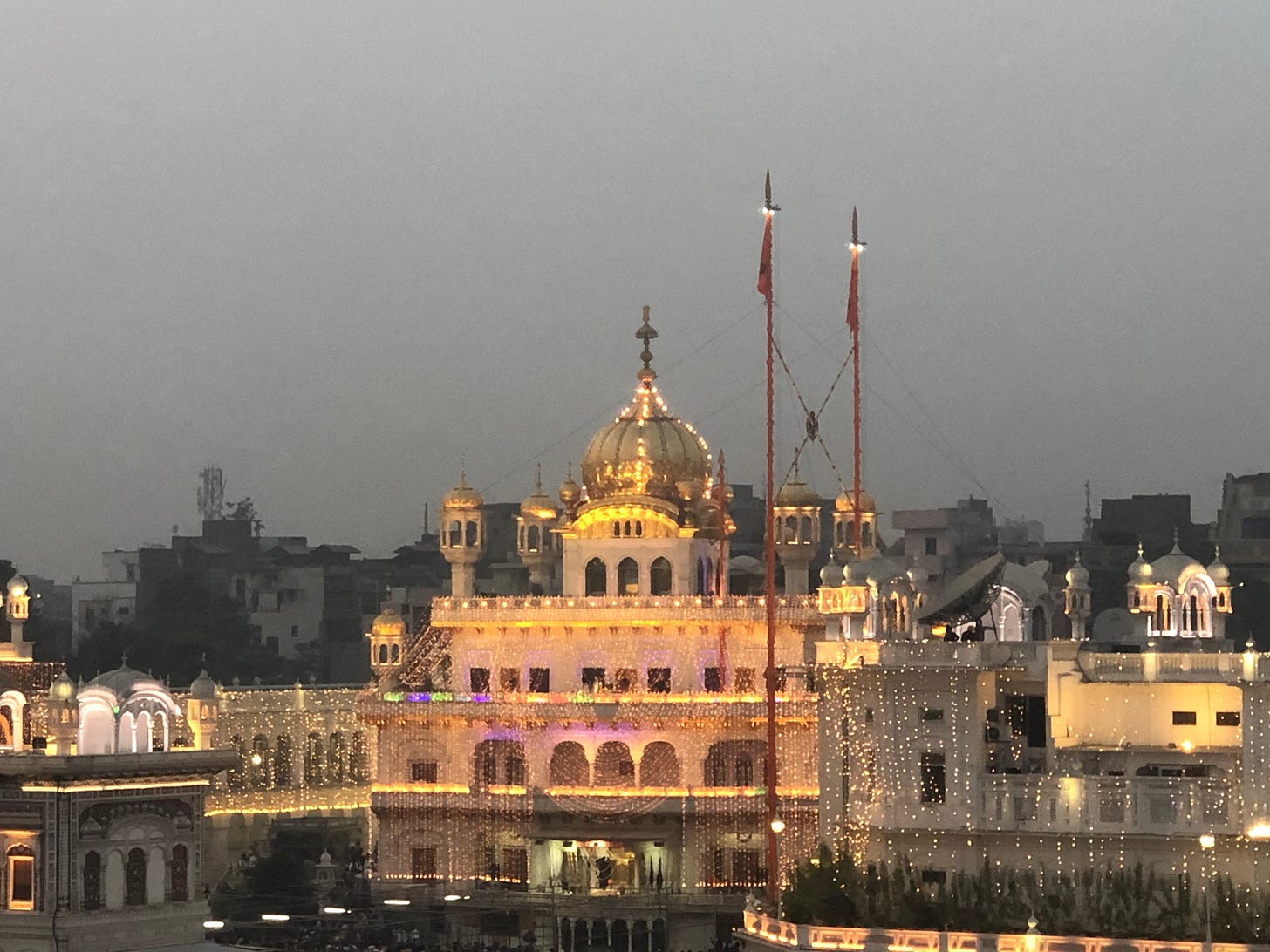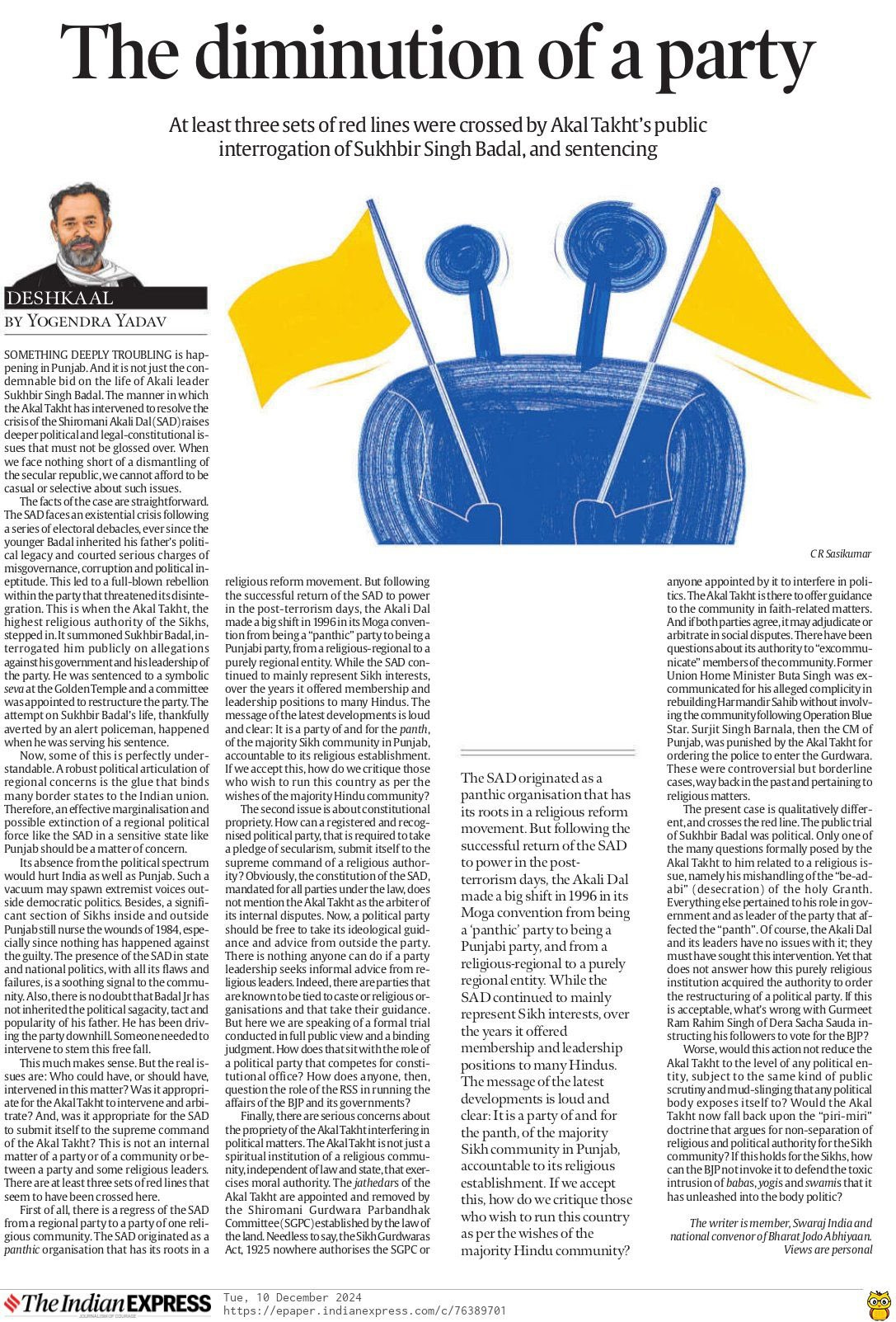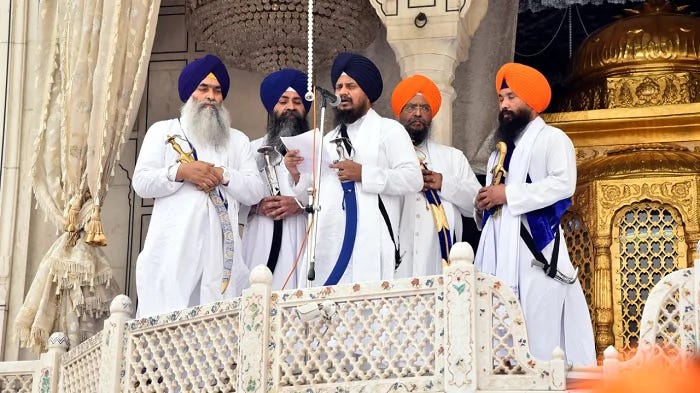A Misinterpretation of the Akal Takht’s Religious Authority vis-à-vis the Shiromani Akali Dal
A Misinterpretation of Sikh's Supreme Temporal Authority: A Response to Yogendra Yadav
A Misinterpretation of Religious Authority of Akal Takht: A Response to Yogendra Yadav
In his article "The Diminution of a Party," Yogendra Yadav examines several critical aspects of the recent actions of the Sri Akal Takht qua Sukhbir Singh Badal, the former Deputy Chief Minister of Punjab and his colleagues. His analysis touches upon three intersecting issues: the public interrogation and directives issued to Badal by the Akal Takht, the historical evolution of the Shiromani Akali Dal (SAD) from a religious-reform movement to a political party, and the constitutional and legal implications of religious authority influencing political entities.
While Yadav's scholarship and rational perspective are well-recognized, his interpretation of these proceedings fundamentally mischaracterizes the nature of the Akal Takht’s actions and authority. Our critique below addresses this misunderstanding while providing clarity on the Akal Takht's clearly defined and universally accepted role within Sikhism, as regards temporal affairs. This may be read in addition to our YouTube video which we had live-streamed immediately after the pronouncement of the formal punishment (‘tankhah’) to explain the finer nuances of this religious process, deeply rooted in the tradition and customs of Sikhism.
Historical Context and Religious Authority
Yadav rightly traces the evolution of the SAD, from its origins as a panthic organization to its role as a political entity representing Sikh and Punjab-centric interests. He notes how the party redefined its character in the post-terrorism era, particularly after the 1996 Moga Convention. However, his analysis overlooks the Akal Takht’s unchanging role as the supreme temporal authority for Sikhs, which transcends political developments and remains rooted in the religious and moral fabric of the Sikh community, worldwide and not just in Punjab or India.
The Akal Takht’s authority is not merely statutory or political but is deeply entrenched in Sikh tradition and history, going many centuries before the British-era enactment of the Sikh Gurdwaras Act, 1925, which currently defines the mode of appointment as well as the removal of the Jathedar of Akal Takht. It functions as the ultimate arbiter of religious discipline and moral accountability, binding Sikhs irrespective of their political or professional affiliations.
Nature of the Proceedings
Yadav’s comparison of the Akal Takht’s proceedings to political or criminal censure demonstrates a fundamental misreading of their purpose. These actions were neither punitive nor politically motivated but were intended to enforce spiritual atonement and moral accountability within the Sikh framework.
The proceedings were explicitly religious, targeting individuals as members of the Sikh faith rather than as political figures. This is evident from the selective summoning of Sikh ministers, excluding Hindu ministers of the same cabinet, headed by late Parkash Singh Badal, reinforcing and categorically accentuating the spiritual-cum-religious nature of the directives.
Misunderstanding of the Akal Takht’s Authority
Yadav’s assertion that these proceedings diminish the SAD as a political entity fails to recognize the Akal Takht’s overarching temporal authority. Its directives are binding on Sikhs not because of their political affiliations but because of their commitment to the Sikh faith. Political positions held by individuals are incidental and do not shield them from religious accountability.
The Akal Takht’s moral authority and historical significance extend far beyond the confines of statutory definitions. It is not merely an institutional appendage of the Sikh Gurdwara Act, 1925, but an enduring symbol of collective conscience and governance in the Sikh community, created by the sixth Sikh Guru, Sri Hargobind ji, who introduced the concept of Miri-Piri.
Scope and Jurisdiction
Yadav’s concerns about the intersection of religious authority and political parties neglect key distinctions:
The Akal Takht’s jurisdiction is limited to matters of faith and religious discipline within the Sikh community.
The proceedings were part of an internal spiritual-cum-religious process, focused on healing and restoring religious integrity, and ensuring justice for the wider Sikh community.
Any statutory or legal implications, such as those involving the Election Commission, or the ongoing criminal trials relating to police firing etc., exist independently of the Akal Takht’s religious mandate.
The Akal Takht’s actions should be understood within this framework rather than being conflated with broader constitutional or political concerns, or other legal processes.
The Religion-Politics Nexus: A Perennial Gray Area
It would indeed be intriguing if the Election Commission of India (ECI) were to initiate proceedings against the Shiromani Akali Dal (SAD) based on the Akal Takht’s directives. Such a move would inevitably spotlight the broader entanglement of politics and religion in India, an issue that is often swept under the rug. While the ECI has issued clear guidelines prohibiting appeals to religion during electoral campaigns and barring the use of places of worship for canvassing, these rules are more honored in breach than in observance. Political parties across the spectrum have repeatedly leveraged religious sentiments and institutions to galvanize voter support, blurring the line between constitutional secularism and practical religiosity.
This dynamic becomes particularly problematic when examining entities like the Bharatiya Janata Party (BJP), whose ideological underpinnings and operational strategies are closely aligned with the Rashtriya Swayamsevak Sangh (RSS). The BJP’s Hindutva agenda frequently intersects with its political objectives, creating a framework where religion and governance become apparently inseparable. Similarly, parties like Asaduddin Owaisi’s All India Majlis-e-Ittehad-ul-Muslimeen (AIMIM), while constitutionally secular, operate with overtly faith-based agendas. Such contradictions reveal a systemic issue within Indian democracy, where the secular ethos is often compromised for political expediency. If the ECI were to single out SAD on these grounds, it could open a Pandora’s box, leading to contentious debates and scrutiny of other political entities, potentially unraveling the already fragile balance between religion and politics in the nation.
Conclusion
Yogendra Yadav’s articulate views are respected, and his analysis of unfolding events from a statutory and legal perspective is acknowledged. However, his interpretation of the Akal Takht’s actions reflects a fundamental misunderstanding of their inherently religious nature. By conflating a spiritual process of atonement with political maneuvering, Yadav not only diminishes the unique role of the Akal Takht but also oversimplifies the nuanced relationship between religion and politics in Punjab. His comparison to other political or religious contexts is both reductive and misplaced, failing to account for the Akal Takht’s unparalleled moral and spiritual and temporal authority.
While Yadav is welcome to continue his analysis within the narrow confines of constitutional and legal frameworks, he would do well to exercise caution when commenting on the internal affairs of the Sikh community. Sri Akal Takht, as the supreme temporal authority, operates beyond the statutory definitions of institutions like the Sikh Gurdwara Act, 1925, standing as a beacon of moral and spiritual governance for Sikhs worldwide. Throughout history, the high and the mighty, including Maharaja Ranjit Singh, and in the modern era, Giani Zail Singh, Surjit Singh Barnala, and Buta Singh, have bowed to its authority and willingly accepted the ‘tankhah.’ One can only hope that this process of religious atonement fosters not only internal spiritual healing but also contributes to a more robust and secular electoral arena in Punjab—long celebrated for its pioneering role in “true” secularism, often surpassing the standards of many states both north and south of the Vindhyas.
Miri-Piri Concept of Guru Hargobind Ji: A Point of Inflexion in the Evolution of Sikhism
Point of Inflexion in Sikhism
Jathedar Akal Takhat: Balancing Tradition and Legal Framework
Introduction: On 16th June, 2023, the Executive Committee of the Shiromani Gurdwara Parbandhak Committee (SGPC) appointed Giani Raghbir Singh as the new Jathedar of Sri Akal Takhat Sahib, relieving Giani Harpreet Singh of this additional charge. Giani Harpreet Singh would, however, continue as Jathedar of Takhat Sri Damdama Sahib, Talwandi Sabo, his sub…







ਸਿੱਧੂ ਸਾਹਿਬ
ਅਕਾਲ ਤਖ਼ਤ ਮਹਾਨ ਹੈ ਸਿੱਖ ਕੌਮ ਦੀ ਸ਼ਾਨ ਹੈ
ਪਰ ਜਦੋਂ ਸਿੱਖ ਹੀ ਚਲਾਕੀਆਂ ਕਰਨ ਲੱਗ ਪੈਣ ਅਤੇ ਤਖ਼ਤ ਸਾਹਿਬ ਦੀ ਮਰਿਆਦਾ ਅਤੇ ਪ੍ਰੀਭਾਸ਼ਾ ਹੀ ਬਦਲ ਦੇਣ ਫਿਰ ਹੋਰਨਾਂ ਨੂੰ ਕੀ ਕਹਿਣਾ।
ਵੇਖੋ ਚਲਾਕੀਆਂ ਕਰਨ ਵਾਲਿਆਂ ਦਾ ਹਸ਼ਰ ਕੀ ਹੋਇਆ ਹੈ ਅਤੇ ਅੱਗੋਂ ਜੋਂ ਹੋਣ ਵਾਲਾ ਹੈ ਇਹਨਾਂ ਨੂੰ ਕੱਖਾਂ ਤੋਂ ਹੌਲਾ ਕਰ ਦੇਵੇਗਾ।
ਨਦਰਿ ਉਪਠੀ ਜੇ ਕਰੇ ਸੁਲਤਾਨਾ ਘਾਹੁ ਕਰਾਇਦਾ ਦਰ ਮੰਗਣ ਭਿਖ ਨਾ ਪਾਇਦਾ